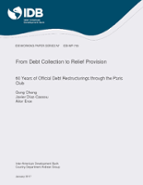From Debt Collection to Relief Provision: 60 Years of Official Debt Restructurings through the Paris Club
Date
Jan 2017
Despite the frequency of official debt restructurings, little systematic evidence has been produced on their characteristics and implications. Using a dataset covering more than 400 Paris Club agreements, this paper aims to fill that gap. It provides a comprehensive description of the evolving characteristics of these operations and studies the economic dynamics surrounding them. The progressive introduction of new terms of treatment gradually turned the Paris Club from a mere debt collector into a sequenced provider of debt relief. The study finds that more generous restructuring conditions involving nominal relief are associated with higher economic growth. In contrast, agreements including only NPV relief have no positive impact on growth. However, the countries that get these restructuring conditions turn out to be more likely to pursue a prudent fiscal policy after the event than those receiving a nominal haircut. In other words, when deciding upon the type of relief to be granted through debt restructuring, the official sector faces a trade-off between the objectives of stimulating growth and fostering fiscal sustainability.



